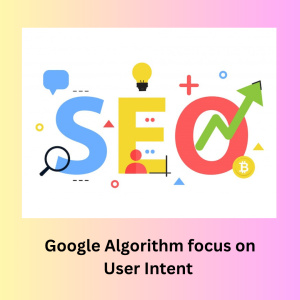
Google algorithm in 2025 has evolved into a sophisticated, AI-driven system that can comprehend not only what users search for, but why they search for it. This shift toward understanding user intent has changed the way SEO works for businesses, bloggers, and marketers alike.
In this blog, we’ll explore how the Google algorithm interprets user behavior in 2025 and what strategies are essential for SEO success in this new era.
What is Google Algorithm and Its Role in SEO?
The Google algorithm is a complex system of rules, processes based on which it determines which web pages appear in search results and in what order. Its primary purpose is to provide the most relevant, accurate, and helpful content to users based on their search queries.
Over the years, the Google algorithm has been updated hundreds of times. From early updates like Panda and Penguin, which focused on content quality and backlink profiles, to more recent developments like Rank Brain, BERT, and Helpful Content Update (HCU)—Google has consistently refined how it interprets and ranks content.
In SEO, understanding how the Google algorithm functions is crucial. It helps website owners create content that aligns with what search engines value most: relevance, quality, trustworthiness, and user satisfaction. Ranking high in search results isn’t just about inserting the right keywords anymore—it’s about understanding user intent.
How Google Algorithm Focuses on User Intent for SEO in 2025
1. Shift from Keyword Matching to Semantic Search
Rather than merely matching exact phrases, the 2025 Google algorithm identifies context and semantics. For example, a user searching for “best phone for travel” will see results that include recommendations, comparisons, and even accessories for it based on inferred intent.
2. AI and Machine Learning Integration
Google uses machine learning to continuously refine results based on user engagement. If people consistently click and stay longer on certain types of content for a given query, the algorithm learns to prioritize that content structure. This helps serve searchers better and discourages clickbait or low-value content.
3. Search Intent Categories Are Better Defined
The Google algorithm now categorizes intent more precisely:
- Informational: To Know about a term (e.g., “how to make pasta”)
- Navigational: Trying to find a specific site (e.g., “Facebook login”)
- Transactional: Ready to buy or sign up (e.g., “buy iPhone 15 online”)
- Local/Commercial: Looking for services near them (e.g., “real estate agents in Pune”)
Understanding this classification helps Google match content more accurately to users’ needs.
4. Personalization & Contextual Signals
The algorithm considers more personalized signals like location, device type, search history, and even voice tone in voice searches. This hyper-contextual matching ensures that two users searching for the same term might see completely different results—each tailored to their individual behavior and history. Suppose A user is searching for “Top restaurants near him” Then all restaurants near his locality will be visible to him based on location on Google.
5. SGE (Search Generative Experience)
With the rollout of SGE, Google now generates AI-powered summaries for many queries. This pushes websites to provide deeply valuable and well-structured content so that snippets of it may be used directly in these AI summaries. Only highly relevant, high-quality content gets surfaced
Ways to Adapt in SEO to Sustain Google Algorithm in 2025
1. Focus on Intent-Based Keyword Research
Instead of just targeting high-volume keywords, identify the intent behind them. Use tools like SEMrush, AHREFS, or Google’s “People Also Ask” feature to understand what users really want to know when they search. Create content that solves problems, answers questions, or guides decisions.
2. Create High-Quality, In-Depth Content
Thin content doesn’t rank. To meet the expectations of the modern Google algorithm, your pages must be:
- Informative (answering the query clearly)
- Well-structured (using headings, lists, tables)
- Expert-backed (written or reviewed by specialists in the niche)
E-A-T (Expertise, Authoritativeness, Trustworthiness) is still crucial.
3. Optimize for Semantic SEO
Use related terms, synonyms, and LSI keywords naturally throughout your content. This helps Google understand the full context of your page. For example, if your page is about “running shoes,” you might include terms like “footwear,” “cushioning,” “trail running,” etc to get considered.
4. Improve UX and Engagement Signals
The Google algorithm monitors how users interact with your site. Reduce bounce rates and increase dwell time by:
- Using fast-loading, mobile-optimized designs
- Adding engaging visuals and interactive elements
- Organizing content for readability and quick scanning
5. Leverage Structured Data
Add schema markup to your pages so that Google can better understand and categorize your content. Structured data also boosts your chances of appearing in rich results or being included in AI summaries.
6. Monitor and Adapt to Updates
SEO is no longer “set and forget.” Use Google Search Console, Analytics, and industry news sources to track changes in traffic or rankings. When the Google algorithm updates, evaluate what pages dropped and adjust accordingly suitable to rules of new update.
Conclusion
In 2025, succeeding in SEO is about creating meaningful experiences—not just chasing rankings. As the Google algorithm grows more intelligent and intent-focused, businesses and content creators must shift their strategies to match. By focusing on what users really want, crafting high-quality content, and staying updated with algorithm changes, you’ll be well-positioned to thrive in the future of search.
The Google algorithm is no longer just a search engine tool—it’s a digital gatekeeper of relevance, trust, and user value. Adapt wisely. Partner with Top SEO company in Dubai that can provide you with updates on trends in Google focus for SEO. Hence to Know more about algorithms in 2025 Visit Osumare Best SEO Agency in Dubai.

